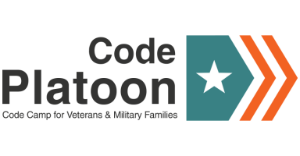Our experience launching a website as a non-profit
Code Platoon officially launched a new website in October of 2018. While the new website looked better, functioned more smoothly, and provided a higher-quality user experience for those outside our organization, what we most appreciated at Code Platoon was the straightforwardness of the development process, thanks to the contributions of many.
In the web development world, projects of this scale often take an enormous amount of time and don’t come out as planned, if they ever make it to deployment. Sometimes they’re outdated by the time they go live. They can be stressful, run way over budget, and functional changes can even end up having unintended, adverse consequences for the organization.
That was not our experience with the Code Platoon 2018 website launch. What was even more improbable was that we were able to circumnavigate those common pitfalls and launch the website of our dreams when we’re a non-profit company without the same resources as bigger businesses on the web.
We’d like to share what our website overhaul considerations and challenges were, how we overcame them, and how other organizations might do the same (especially other non-profits)!
Background
When Code Platoon first opened its doors, volunteer and staff availability was extremely limited.
Providing our veteran and military spouse students with a world-class training program and career transition experience was (and still is) top priority. A website could serve as beacon to educate those who might benefit from such an experience, but at the time, a perfect website was not mission-critical.
What does help, though, is that nonprofits can often receive discounts offered by web design studios, and we were fortunate to do so in establishing our initial website, which also included a hosting plan.
That version of the website, for a time, served its purpose. It displayed our mission, informed stakeholders of our value, and was a catalyst in expanding our program from one to three cohorts per year. It relied on the WordPress content management system, which was intuitive enough that non-technical team members could log in and make changes as needed. As our organization grew, the team added new features, such as a student application form and new visuals.
Without a dedicated web administrator to test changes and maintain quality, and with so much attention focused on the actual program, two things happened: Code Platoon became a force in the coding bootcamp scene, and its website fell behind in effectively communicating that message.
To make things even harder, the backend of the website became increasingly more cumbersome to manage. For example, when a talented volunteer designer created the amazing logo and theme colors we still proudly display, the team sought to globally apply the elements to the website, but the child theme of our hosting provider would no longer permit it. Another volunteer offered to help, and was able to manually code the changes. Cracking open the website template and discovering more issues, though, made it apparent that the first iteration of the website would not be able to scale with the growing organization much longer.
Key Considerations
We could have resolved those concerns on the old website with a bigger budget, but as a nonprofit startup, there wasn’t any extra financial padding built into our budget to cover luxuries such as customization costs from a web design studio or an in-house, full-time paid web development team like a major corporation might have.
And because we are a non-profit that relied on the generosity and participation of many stakeholders, we had lots of potential audiences for our website. Although we needed to reach prospective students, we were also aware that donors, grantors, sponsors, volunteers, staff, and third-party awards organizations would use the website as a focal point in their research. There was an enormous pull to please everyone at once, which made a website project both more complicated in planning and more enormous in scope.
Another potential solution involved leveraging volunteers to develop, deploy and administer the new website. We considered this option for several months and designed prototypes with other themes. We even attempted reformulating the aging website structure and content in order to gain a sense of the scope and magnitude of such an undertaking. During this time we reflected on ways we might maximize our productivity and performance after rolling out a new website, and we created a standard operating procedure for managing future changes.
With more and more hours invested in the process, the unsustainability of fully relying on volunteers became more apparent and significant. Even while some dedicated hosting providers offered in-house customizations at reasonable rates, the possibility of hiring and training their team at a moment’s notice was far from ideal. Hammering out the details of a contract and allowing an established web design studio to build a site from scratch with tried and true tools and practices seemed like the best solution.
That left us with many questions for the potential new provider. If we encountered a problem, would we communicate by phone, chat or email, during what times and with how fast of a turnaround?
At what point would bandwidth and storage limits be enforced? After roll out, to what extent would we be able to customize the site, and would they collaborate with us in that process?
To what degree would they outsource services such as web hosting and WordPress management to third parties, what were their policies, and would we have the ability to interface directly with them as needed?
Were essential services offered, such as optimizations (compression, caching, redirects), continuity (website backups, server backup, and security), security (SSL, brute force protection, password policy, file change detection, spam filtering) and updates (CMS, plugins, staging area)? Were such services included in the contract or provided as add-on costs?
The Code Platoon Solution
After seriously considering and walking away from a few lower cost options, Code Platoon identified a development and hosting provider with an impeccable track record, a commitment to quality, and the flexibility to meet our unique demands. With cost a potential sticking point, they worked with us to structure a plan that we could justify to our stakeholders in the immense value we would attain in the short and long term.
Once the decision was made, our team fielded each team member’s valuable perspectives in order to refine the website mockup into the best it could possibly be: strategy, planning and execution, look and feel, technical requirements, SEO, and stakeholder outreach were all thoroughly deliberated and settled by consensus. When the time arrived for our design studio to lay the hammer to the chisel, progress was quick, and before long, the basic site structure was complete.
We could have at that point rushed the remaining work to publish the site in a much shorter time frame. Instead, we had each member comb the site with its array of new features to assess whether new opportunities existed for further improvement that we may not have considered at the outset of planning. Sure enough, we ended up with plenty of new requests that we didn’t imagine could all be accepted and implemented.
To our surprise, the design studio was fully on-board with the revised requirements and invested in making the site the best it could possibly be. To ease communication, a Code Platoon volunteer became the liaison between both teams and expedited the remaining changes. At a point where the site was publishable, our team applied another quality control comb through and arrived at a much smaller, easily implementable list of revised requests, and prioritized those that were necessary for launch versus those that could be implemented later.
Reflection
We got the website we wanted in a budget and timeline that we could handle and still have a happy, ongoing relationship with our web developer.
We were able to achieve these results by:
1. Focusing on our mission.
We decided early on that the website layout and messaging needed to focus primarily on our potential students. We had faith in our supporters to see the website as a portal for applicants above all. And not just in terms of where the most resources were committed, but also in removing distractions for students that might be appealing to other audiences.
2. Relying on dedicated people who understood the mission.
For us, this was our volunteer and staff team, our sponsors, grantors, and donors, and our world-class web design studio, Digital Ammo.
If you are an organization under similar circumstances, start with a simple goal. Collaborate with all of your stakeholders, and reflect on each soft decision to consider different perspectives before finalizing. Compromise, get consensus early in the project, and follow qualified expertise whenever you reach an impasse.
And most of all, never lose sight of the mission.

